Imagine a majestic tree standing tall in your yard, providing shade and beauty, only to realize its roots are damaged. Is it possible to save it? The answer is yes, with the right knowledge and techniques! In this article, we’ll explore “how to save a tree with damaged roots”: how to identify root damage, protect tree roots during construction, maintain proper watering and soil management, provide nutrient support, stabilize and support the tree, and prevent future root damage. Let’s embark on this journey to save trees that have damaged roots, and preserve their invaluable environmental contributions.
Short Summary
- Identify potential root damage symptoms and observe common issues such as wilting leaves, yellowing foliage, or fungus growth.
- Take proactive steps to protect tree roots during construction with physical barriers and ground covering such as mulch/wood chips.
- Proper watering, soil management, nutrient support, aeration and decompaction can facilitate root access to water, air, and nutrients, aiding the tree in recovering from root damage.
- Prevent future root damage by maintaining a healthy canopy and monitoring root growth via digital imaging or core sampling.
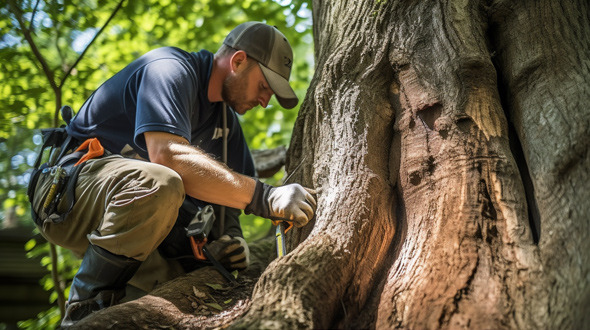 ALT
ALT
Identifying Root Damage
Trees are an essential part of our environment, providing countless benefits. However, their root systems can be susceptible to damage, leading to deterioration and even death if not addressed promptly. One way to identify potential issues is by examining the tree trunk for signs of distress and observing the tree’s roots for any visible damage.
Many factors, including construction, soil compaction, and chemical exposure can cause root damage. Therefore, it is crucial to identify tree root damage and understand its causes to provide the necessary care and save the tree.
Symptoms of Damaged Tree Roots
How do you know if your tree’s roots are damaged? Look for common indications such as wilting leaves, yellowing foliage, and decreased growth. These symptoms can be subtle, but they serve as a warning sign that something is not quite right with your tree’s roots. Other signs of potential root damage include fungal fruiting bodies, leaf scorch, stunted growth, slow drains, sudden drop in water availability, offensive odor, and leaning trees.
Be vigilant and monitor your tree for any signs of distress, as timely treatment may save the tree from further deterioration.
Causes of Root Damage
Construction activities are one of the most common causes of root damage, often resulting in soil compaction and severed roots. Additionally, improper pruning, tree-removal techniques, scraping bark off trunks, or causing broken branches during construction can cause injury to tree branches and trunks.
Chemical seepage, such as paint, stain, concrete, sealers, and cleaning chemicals can poison a tree, starting at the roots and causing serious damage or death. Understanding these causes is crucial in taking preventive measures and properly caring for your tree during and after construction activities.
Protecting Tree Roots During Construction
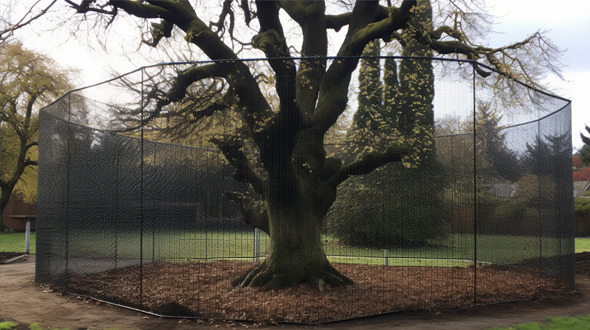 ALT
ALT
Tree roots are often vulnerable during construction projects, and taking steps to protect them is essential for the tree’s health and longevity. Establishing barriers around the root zone and managing heavy equipment and foot traffic near tree trunks can significantly reduce the risk of root damage.
In this section, we will explore the use of barriers and how to avoid heavy equipment near tree trunks to protect your tree during construction.
Barriers Around Root Zone
Physical barriers, such as retaining walls, terraces, or root barriers made from thick plastic sheeting material, can effectively safeguard tree roots during construction. Ideally, the barrier should be situated at the tree’s drip line to protect the roots most effectively.
Additionally, covering the exposed roots with mulch or wood chips can help maintain soil moisture, providing further protection and support for the tree during construction activities.
Avoiding Heavy Equipment Near Tree Trunks
Operating heavy machinery near tree trunks can lead to the following:
- Soil compaction
- Decreased stability
- Disrupted nutrient absorption
- Damage to the trunk or limbs due to equipment
Root bruising or crushing caused by heavy machinery may not be visible at the surface, so it is crucial to avoid using heavy machinery near tree trunks.
Various approaches can be employed to address soil compaction, such as aerating and decompacting compacted soil around the tree. This will help ensure the tree’s roots have access to necessary resources and can recover from damage.
Watering and Soil Management
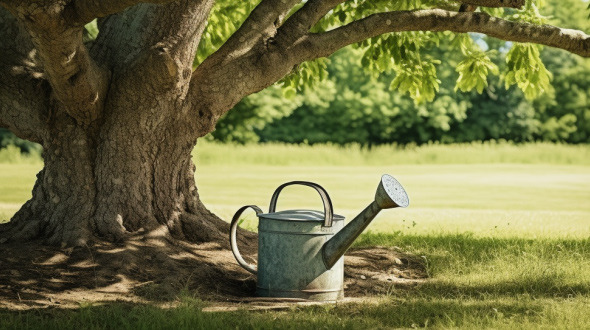 ALT
ALT
Proper watering and soil management are vital to helping trees recover from root damage. Watering damaged trees allows them to absorb nutrients from the soil, facilitating their recovery.
This section will discuss effective watering techniques for damaged roots and the importance of soil aeration and decompaction.
Watering Techniques for Damaged Roots
Before watering a damaged tree, assess the dryness of the soil with a screwdriver to ensure watering is necessary. Water the tree thoroughly, but avoid overwatering, as this could cause further harm to the tree, such as rot, and may increase the likelihood of failure if the tree already exhibits a lean.
After providing hydration, observe the tree for any indications of improvement, such as reduced leaf wilting or new growth.
Soil Aeration and Decompaction
Soil aeration, the process of creating air spaces in the soil, is essential for damaged tree roots as it reduces soil compaction and enhances root access to critical resources. Aerating and decompacting the soil can be done manually with a garden fork, aerator, or a machine such as a rototiller.
By improving soil aeration and decompaction, you can facilitate root access to water, air, and nutrients, aiding the tree in recovering from root damage.
Nutrient Support for Damaged Trees
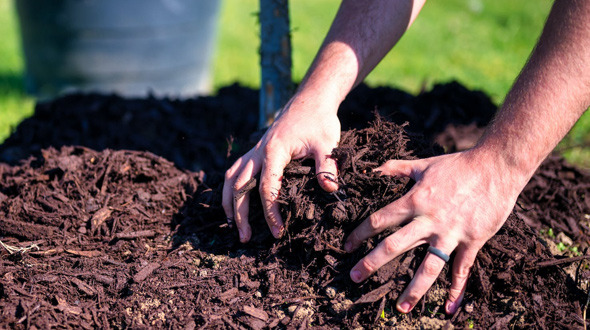 ALT
ALT
Providing nutrient support to damaged trees can significantly improve their chances of recovery. Organic materials, such as mulch and compost, can supply nourishment to damaged trees, improving soil health and supporting tree recovery.
In this section, we will discuss using organic materials for nutrient support and proper application techniques to avoid further damage to the tree.
Organic Materials: Mulch and Compost
Mulch and compost are widely used organic materials for nutrient support to damaged trees. Applying mulch to the soil surface can help mitigate fluctuations in soil temperature and moisture levels and add organic material to enhance soil health.
Similarly, applying compost to the soil surface can enhance soil structure, augment water retention, and supply essential nutrients to the tree.
Proper Application Techniques
To ensure the effectiveness of organic materials in supporting tree recovery, it is crucial to apply them correctly. Here are some guidelines to follow:
- Apply organic materials in a layer of 2-4 inches around the base of the tree.
- Avoid contact with the trunk to prevent rot and disease.
- Allow the tree to benefit from the nutrients provided by the organic materials.
By following these guidelines, you can ensure that organic materials effectively support tree recovery.
Organic materials should be applied in the spring or fall when the soil is moist, and temperatures are low.
Stabilizing and Supporting the Tree
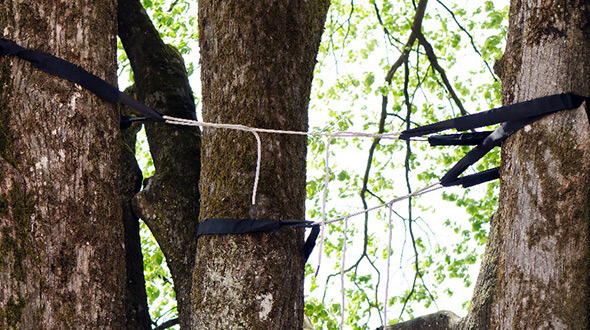 ALT
ALT
Trees with damaged roots may require additional support and stabilization to prevent leaning and weakening. In this section, we’ll discuss the use of cabling and limb support for stabilizing and supporting the tree. Cabling involves attaching a cable between two branches or between a branch and the trunk of the tree. This helps to reduce the strain on the tree and can help prevent diseases.
Cabling and Limb Support
Dynamic tree cabling and limb support is a method of providing additional support to a tree with damaged roots. By utilizing tree support straps or guy wires to anchor and safeguard the tree, you can help prevent the leaning and weakening of the tree. It is imperative to use broad, sturdy strapping and tie the tree loosely so it can still move slightly.
Additionally, driving one or two parallel stakes into the soil just outside the root ball and securing the tree to the stakes can provide further support and stability.
Tree Removal Considerations
In some cases, a tree may have sustained significant damage and cannot be stabilized or supported. Tree removal may be the only viable option in these situations. When assessing a tree for removal, consider the following factors:
- Size of the tree
- Species of the tree
- Condition of the tree
- Proximity to nearby structures or powerlines
These factors will help determine whether tree removal is necessary and the best course of action.
Adhering to local tree removal ordinances and enlisting the services of a certified tree removal service will ensure the safe and efficient removal of the tree.
Preventing Future Root Damage
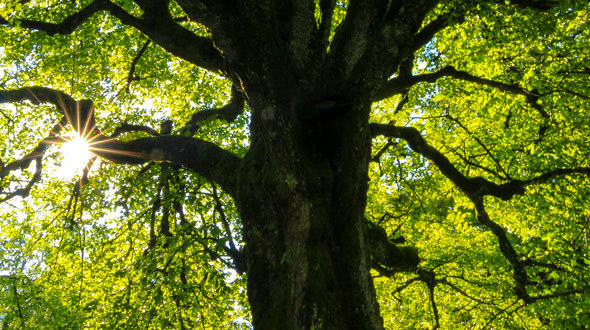 ALT
ALT
Preventing future root damage is essential for maintaining the health and longevity of your trees. Maintaining a healthy tree canopy and monitoring root growth can detect and address potential issues early and avoid future root damage.
This section will discuss the importance of maintaining a healthy tree canopy and monitoring root growth.
Maintaining a Healthy Tree Canopy
A healthy tree canopy is crucial for overall tree health and preventing root damage. Here are some ways to help prevent future root damage.
- Install root barrier prior to planting trees
- Keep tree roots hidden within the dripline
- Use permeable pavers in walkways or patios that permit water and air to reach the roots
Following these practices can maintain a healthy tree canopy, protect tree roots, and prevent root damage.
Additionally, watering techniques tailored to the tree species and soil type, and regular monitoring and maintenance can help ensure a healthy tree canopy and prevent future root damage.
Monitoring Root Growth
Monitoring root growth is essential for early detection, addressing potential issues, and preventing future root damage. Tree professionals and arborist monitor root growth through employing techniques such as:
- recording root images with digital cameras
- rotating scanners
- core sampling
- electrical impedance spectroscopy
Additionally, conducting root collar excavation to observe the roots can provide valuable insights into the tree’s overall health and its root system.
Summary
In conclusion, saving a tree with damaged roots is possible with the proper knowledge and techniques. By identifying root damage, protecting roots during construction, maintaining proper watering and soil management, providing nutrient support, stabilizing and supporting the tree, and preventing future root damage, we can preserve trees’ invaluable contributions to our environment. Remember, every tree is worth saving, and with proper care and attention, we can ensure their continued growth and health for generations to come.
Frequently Asked Questions
Can a tree survive with damaged roots?
Tree roots can experience some damage and survive, but if the damage is extensive, extra care may be needed to help save the tree. In these cases, it is recommended to consult a tree care specialist for guidance.
How do you fix root damage?
To fix root damage of a plant, remove the plant from the pot, trim away the rotting roots, prune back the foliage, toss the original soil, and wash the pot with a bleach water solution.
This will help ensure the plant is free of any disease or pests that may have caused the root damage. It is essential to replace the soil with a fresh, nutrient-rich mix and to repot the plant in a larger pot if necessary.
Can I cut tree roots without killing the tree?
Cutting tree roots should only be done when absolutely necessary and with care, as there is no guarantee that it won’t hurt or eventually kill the tree.
Experts recommend avoiding cutting roots unless they are damaging property or growing through construction areas.
How can I protect tree roots during construction?
To protect tree roots during construction, create a barrier around the root zone and avoid heavy machinery near the trunks.
This will help to prevent damage to the roots and ensure the trees remain healthy.
What is the importance of soil aeration and decompaction for damaged tree roots?
Soil aeration and decompaction are essential for damaged tree roots, as they reduce soil compaction and improve root access to essential resources such as water, air, and nutrients. This helps maintain the health of the tree.
Todd’s Marietta Tree Services
Marietta, GA
(678) 505-0266
Originally published on: https://www.toddsmariettatreeservices.com/how-to-save-tree-with-damaged-roots/